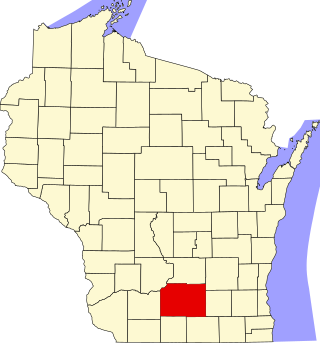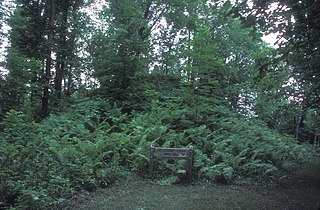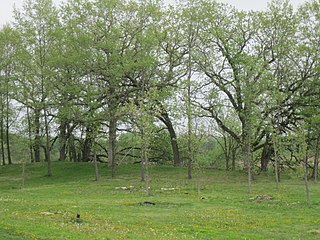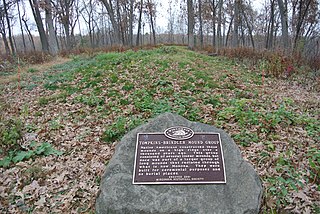
Aztalan State Park is a Wisconsin state park in the Town of Aztalan, Jefferson County. Established in 1952, it was designated a National Historic Landmark in 1964 and added to the National Register of Historic Places in 1966. The park covers 172 acres (70 ha) along the Crawfish River.

The Great Serpent Mound is a 1,348-foot-long (411 m), three-foot-high prehistoric effigy mound located in Peebles, Ohio. It was built on what is known as the Serpent Mound crater plateau, running along the Ohio Brush Creek in Adams County, Ohio. The mound is the largest serpent effigy in the world.

Lizard Mound State Park is a state park in the Town of Farmington, Washington County, Wisconsin near the city of West Bend. The park contains a significant well-preserved effigy mound group, representing one of the largest and best-preserved collections of such mounds in the state. Mounds in the park are the subject of at least two different listings on the National Register of Historic Places, one encompassing the park as a whole, and another which includes a larger set of regional mounds. Established in 1950, the park was acquired by Washington County from the state of Wisconsin in 1986, and was returned to the state in 2021. It is now managed by the Wisconsin Department of Natural Resources.

Shiloh Indian Mounds Site (40HR7) is an archaeological site of the South Appalachian Mississippian culture. It is located beside the Tennessee River on the grounds of the Shiloh National Military Park, in Hardin County of southwestern Tennessee. A National Historic Landmark, it is one of the largest Woodland era sites in the southeastern United States.

The Kolomoki Mounds is one of the largest and earliest Woodland period earthwork mound complexes in the Southeastern United States and is the largest in Georgia. Constructed from 350CE to 600CE, the mound complex is located in southwest Georgia, in present-day Early County near the Chattahoochee River.

An effigy mound is a raised pile of earth built in the shape of a stylized animal, symbol, religious figure, human, or other figure. The Effigy Moundbuilder culture is primarily associated with the years 550–1200 CE during the Late Woodland Period, although radiocarbon dating has placed the origin of certain mounds as far back as 320 BCE.

This is a list of the National Register of Historic Places listings in Dane County, Wisconsin. It aims to provide a comprehensive listing of buildings, sites, structures, districts, and objects in Dane County, Wisconsin listed on the National Register of Historic Places.

The Alligator Effigy Mound is an effigy mound in Granville, Ohio, United States. The mound is believed to have been built between AD 800 and 1200 by people of the Fort Ancient culture. The mound was likely a ceremonial site, as it was not used for burials.

Rock Eagle Effigy Mound is an archaeological site in Putnam County, Georgia, U.S. estimated to have been constructed c. 1000 BC to AD 1000. The earthwork was built up of thousands of pieces of quartzite laid in the mounded shape of a large bird. Although it is most often referred to as an eagle, scholars do not know exactly what type of bird the original builders intended to portray. It is listed on the National Register of Historic Places (NRHP) because of its significance. The University of Georgia administers the site. It uses much of the adjoining land for a 4-H camp, with cottages and other buildings, and day and residential environmental education.

The Mines of Spain State Recreation Area and E. B. Lyons Nature Center is a state park in Dubuque County, Iowa, United States. It is near Dubuque, the eleventh-largest city in the state. The park features picnic areas, 15 miles (24 km) of walking/hiking trails, 4 miles (6.4 km) of ski trails, and the Betty Hauptli Bird and Butterfly Garden. It also includes archaeological sites of national importance as an early lead mining and smelting venture led by French explorer Julien Dubuque, as well as Dubuque's gravesite. These sites were collectively designated a National Historic Landmark District as Julien Dubuque's Mines.

The Portsmouth Earthworks are a large prehistoric mound complex constructed by the Native American Adena and Ohio Hopewell cultures of eastern North America. The site was one of the largest earthwork ceremonial centers constructed by the Hopewell and is located at the confluence of the Scioto and Ohio Rivers, in present-day Ohio.

Cranberry Creek Archeological District, also known as Cranberry Creek Mound Group, is an ancient American Indian burial mound site from circa AD 100–800 near New Miner, Wisconsin, United States. It is three miles east of Necedah National Wildlife Refuge in Juneau County. It is part of the "effigy mound culture" of native peoples in Wisconsin, who practiced the "respectful burial of their dead".

Grand Mound is a prehistoric burial site in Koochiching County, Minnesota, United States. It is the largest surviving prehistoric structure in the upper Midwest, dating back to 200 BCE. The site was listed as a National Historic Landmark on June 23, 2011.

This is a list of the National Register of Historic Places listings in Madison, Wisconsin.

The Vilas Park Mound Group is a group of Native American mounds in Vilas Park in Madison, Wisconsin. The group includes a bird effigy, a linear mound, and six conical mounds. It originally included another bird effigy and two additional conical mounds, but development destroyed these mounds and damaged two of the existing ones.

The Elmside Park Mounds are a group of Native American mounds in Elmside Park in Madison, Wisconsin. The group includes two animal-shaped effigy mounds; while their shapes are inconclusive, they have been described as a lynx and a bear. The mounds were once part of the Oakridge Mound Group, which included three other mounds, but the others were destroyed by home construction. Mound Builder peoples built the mounds in the Late Woodland period, likely between 800 and 1100 A.D., to serve as burial and ceremonial sites. The mounds may be the only remnant of a Late Woodland community on the northeast shore of Lake Monona and are archaeologically significant in the study of Late Woodland civilizations.

The Mills Woods Mound, also known as the Hudson Park Mound, is a Native American mound in Hudson Park in Madison, Wisconsin. It is an animal-shaped effigy mound with a long tail, though the exact animal it represents is unclear. The mound was once part of the large Mills Woods Mound Group, which included roughly thirty mounds of various shapes, but construction destroyed every other mound in the group. The mound group was built during the Late Woodland period, roughly between 800 and 1100 A.D., by a Mound Builder group; the Mound Builders used mounds for burials and ceremonial purposes. The mound is one of less than 60 effigy mounds remaining in Dane County, which once had 289 of the mounds, and has potential archaeological significance for the study of Late Woodland civilizations.

The Pflaum-McWilliams Mound Group, also known as the Edna Taylor Conservancy Mound Group, is a group of Native American mounds in Madison, Wisconsin. Located in the Edna Taylor Conservancy in southeast Madison, the group includes an animal effigy mound and six linear mounds. The linear mounds are unusually long compared to other surviving mounds in the Madison area; the longest is 484 feet (148 m), and several are over 200 feet (61 m) in length. While a number of the linear mounds have been damaged, the group is generally well-preserved. The mounds were built during the Late Woodland period, most likely between 800 and 1100 A.D., and were thought to have been used for ceremonial purposes.

The Halvorson Mound Group is a group of Native American mounds in Yahara Heights County Park in Madison, Wisconsin. The group includes panther- and bear-shaped effigy mounds as well as an oval-shaped mound; a second panther mound and a linear mound were also once part of the site but were destroyed by farming. The remaining panther mound is a relatively large example at 228 feet (69 m) long. The mounds were built by Late Woodland people roughly between 800 and 1100 A.D. Charles E. Brown and Rev. F. A. Gilmore conducted the first survey of the mounds in 1911.

The Tompkins-Brindler Mound Group is a group of Native American mounds in Woodland Park in Monona, Wisconsin. The group includes two linear mounds which are roughly 200 feet (61 m) and 210 feet (64 m) long. While there were once fifteen mounds in the group, including another group to the southwest called the Nichols Mound Group, the other mounds have all been destroyed. The mounds were built during the Late Woodland period, which covers roughly 500 to 1200 A.D., and during which most mounds in southern Wisconsin were constructed. While the purpose of linear mounds such as those in the Tompkins-Brindler group is uncertain, they are thought to have had religious or spiritual significance to the Late Woodland people.






















